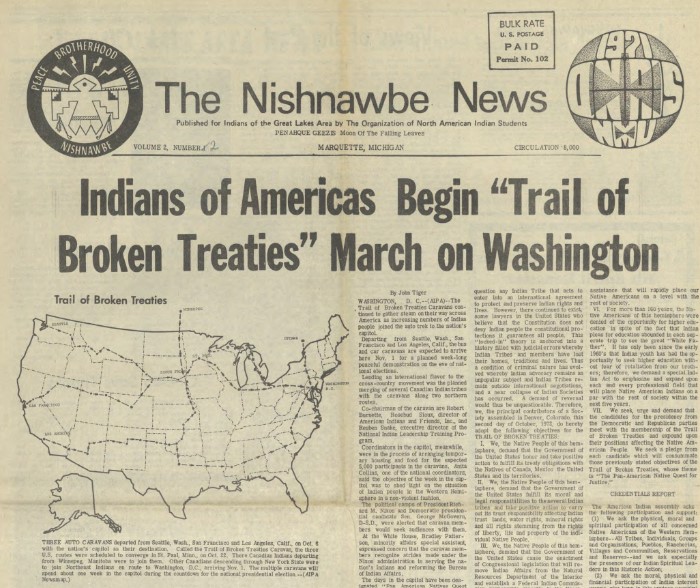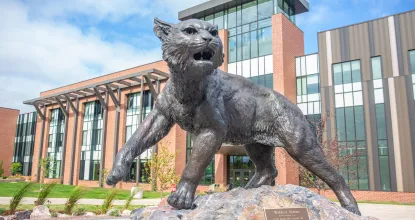Image

Anishnaabe News
Due to limited staffing, the CNAS is no longer able to support the print copy of the Anishnaabe News.
Anishinaabe News is dedicated to featuring Native American-related news, perspectives, and artwork. To view past issues of Anishnaabe News, visit the archives.
The historical Nishnawbe News began in 1971 and grew to a circulation of more than 8,000. Decreases in funding halted publication in 1983. Read more about the history of Anishinaabe News.
Recent Issues
Anishinaabe News 50th Anniversary Edition, Feb 2021
Anishinaabe News Vol. 1 Issue 2, May 2021
Submission Guidelines
Anishinaabe News is dedicated to featuring Native American-related news, perspectives, and artwork. As of December 2022, we are between CNAS Directors and Anishinaabe News is currently not undergoing publication. In the future, however, we will likely return to soliciting news articles, reviews, sports stories, artwork, poetry, and flash fiction for publication as outlined below.
All submissions must be previously unpublished. We allow simultaneous submissions, but please notify us right away if your work is accepted elsewhere. Copyright reverts to the author upon publication. We are unable to offer monetary payment for publications; however, we offer contributors our gratitude and additional copies of the publication.
Written work:
- A submission of written work should be no longer than 1,000 words. We may consider longer, in-depth articles as well.
- Feel free to include photos to accompany your written work.
Visual work:
- Please provide a caption or paragraph to help illuminate the context of your drawing, photo, or other visual work.
Contact Us:
If you have any questions, email us at the address below or call (906) 227-1397.
History
The Anishinaabe News, or Nishnawbe News as it was then known, was first published by Northern Michigan University in July 1971. This first issue was only a four-page paper in tabloid form with a circulation of around 3,000. The newspaper quickly grew in size and readership. After only four issues, Nishnawbe News expanded to twelve pages using the common newspaper broadsheet form. It quickly gained the reputation of being one of the leading Native-American-run newspapers in the country, and its circulation eventually grew to more than 8,000, with issues sent worldwide.

The idea for the newspaper had origins in a meeting held in Zeba, Mich., a small tribal community on the southeastern shore of Keweenaw Bay, in the summer of 1970. At the time, a committee from NMU, led by Jim Carter, met there with the Inter-Tribal Council of Michigan, which included tribal officials from all over the state. Among other things, the ITCM recommended a Native-American-run newspaper because they felt that the non-Native press was very biased then.
Upon returning to NMU, Jim Carter, who worked in NMU’s office of research and development and served as the original director of Native American programs, struggled to find funding for this newspaper. Eventually NMU president John X. Jamrich gave a $10,000 grant to students to fund the first year of the newspaper’s production. This would be one of many contributions President Jamrich would make toward promoting Native American programs. During his tenure, NMU would gain a reputation for being one of the top schools in the country for Native American culture, with Native American enrollment doubling over a six-year period.
On April 19, 1977, six members of the Organization of North American Indian Students met to form the initial staff for the paper. They included Michael Wright, the newspaper’s founding editor, Cheryl King, who would publish a book of Ojibwa legends in 1972, and Robert Van Alstine, who would go on to work for the Bureau of Indian Affairs. These original staff members worked hard to produce a product serving Native American communities that continues with Anishinaabe News today. Student staff never shied away from controversial topics while also focusing on poetry and Native American heritage.
In just two years, Nishnawbe News would grow into the second largest Indian publication in North America, receiving national acclaim in publications like The New York Times and Time magazine. Still, despite the paper’s success, funding remained a constant problem. Again, Jim Carter sent out letters in hope of finding funding. He wrote to senators and congressmen, even U.S. Vice President Spiro Agnew. Every avenue, big and small, was explored to keep the paper going. Throughout Nishnawbe News’s history, grant money came from a variety of sources.
From start to finish, the newspaper was a complete student effort, with Native American students doing all of the writing, editing, reporting and layout. Carter served as an advisor on the newspaper production. Students appreciated his time and efforts, and he was recognized with multiple awards for this service. One thing Jim always wanted to make clear was that he gained more from these students than he gave.
The original version of the newspaper would stay in publication until October 1983, when sharp cutbacks in higher education funding forced Nishnawbe News to publish its last edition.
When Dr. Martin Reinhardt was the Center for Native American Studies director, he brought Anishinaabe News back to life in 2002 as an online offering. The [former] current CNAS director, April Lindala, pushed for a hard copy version and the newsletter we know now is entering its 9th year of publication. It is with the spirit of these founding members that we will continue to publish Anishinaabe News for as long as we can.
—Adapted from “The Beginning of Nish News,” by Gabe Waskiewicz from Anishinaabe News, Volume 9, Issue 1, October 2013.
Archive
Winter 2016
- Volume 11, Issue 3 - March
Fall 2015
- Volume 11, Issue 2 - December
- Volume 11, Issue 1 - November
Summer 2015
Fall 2014
- Volume 10, Issue 1 - October
- Volume 10, Issue 2 - December
Summer 2014
- Volume 9, Issue 5 - August
Winter 2014
- Volume 9, Issue 4 - May
- Volume 9, Issue 3 - March
- Volume 9, Issue 2 - February
Fall 2013
- Volume 9, Issue 1 - October
Summer 2013
- Volume 8, Issue 5 - July
Winter 2013
- Volume 8, Issue 4 - May
- Volume 8, Issue 3 - March
Fall 2012
- Volume 8, Issue 2 - December
- Volume 8, Issue 1 - November
Winter 2011
Winter 2010
Fall 2009
Summer 2009
Winter 2009
Fall 2008
Winter/Spring 2008
Fall 2007
- Pages 12-1
- Pages 2-11
- Pages 10-3
- Pages 4-9
- Pages 8-5
- Pages 6-7
Summer 2006
- Back
- Front
April 2006
- Back
- Front
Nishnawbe News archive: 1971-1982
Access issues of the original Nishnawbe News on UPLink

